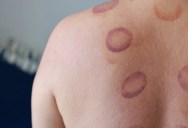What Are The Dark Circles Some Swimmers Have On Their Backs? It’s Called Cupping And It Has Been Used In Medicine Since 1550 BCE.

I know we all just had a ball watching the summer Olympics in Paris, France, and swimming is a super fun and popular sport to view.
You might have noticed that many of the swimmers had dark circles on their backs, but why?
Turns out it’s due to a treatment or procedure known as “cupping.”
Cupping is a very old physical therapy that involves “cups” placed on the skin in order to draw fluid to the area.
The cups are typically glass these days, but in some areas, animal horns are used instead.
The cups are used to create a vacuum that pulls the skin upward into the empty space. This causes the skin’s capillaries to break and bruises to form.

In modern practice, the vacuum is created by suction, but traditionally, fire was used to create the seal.
The cups stay in place for 5-15 minutes, drawing blood to the area and aiding in the healing of scar tissue, according to proponents.
There are two forms, dry cupping and wet cupping. The former doesn’t involve any blood and may be combined with massage, while the latter involves small incisions that leak blood and/or fluid from the body.
“Hacamat” began in Egypt, Macedonia, China, and India, and is mentioned in one of the oldest medical recordings in existence, the Ebers Papyrus.
It was written in 1550 BCE.
The practice is used to treat pain, arthritis, headaches, high blood pressure, and gynecological disorders.

Like a lot of traditional “medicine,” these effects have not been proven by science.
That said, research does suggest it can be beneficial for muscle and lower back pain, but more findings are needed.
That said, it’s safe and the marks fade quickly.
So, you know what they say.
It doesn’t hurt to try.
If you found that story interesting, learn more about why people often wake up around 3 AM and keep doing it for life.

Sign up to get our BEST stories of the week straight to your inbox.




